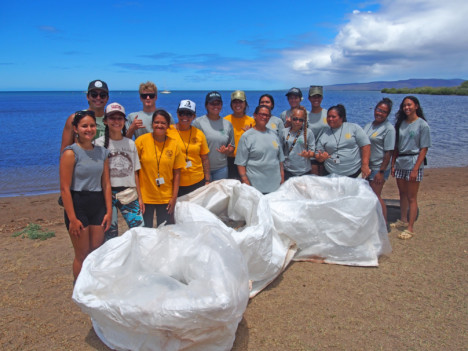Keiki Clean Up Beaches at the Wharf, Canoe Club

Sust‘āinable Molokai and Summer PALS members are seen here with three bags of trash and mangrove seedlings picked up by more than 75 children around Kaunakakai Wharf last Friday. Photo by Léo Azambuja
A three-prong partnership brought together several dozens of keiki to a beach cleanup at Kaunakakai Wharf and at the Molokai Canoe Club Friday morning, gathering about 50 pounds of trash and 100 pounds of invasive red mangrove seedlings.
“This is our second year hosting the beach cleanup with Molokai Holokai,” said Sonja Angst, marketing communications manager at the nonprofit organization Sust‘āinable Molokai.
Angst said about 75 children from Maui County’s Summer PALS program, plus a handful of other keiki from the community showed up at the wharf for the cleanup. The children filled three large bags – two filled with snapped mangrove seedlings and another filled with trash picked up on the shoreline.
The cleanup was a partnership between Sust‘āinable Molokai, Summer PALS and Molokai Holokai, and was held in synchronicity with the start of the Molokai Holokai Ho‘olaule‘a events Friday and Saturday.
Angst said the morning started with the adults educating the children on the types of debris found at the beach and how long they take to decompose. Once the keiki picked up most of the trash, they targeted the mangrove seedlings. Mangrove seedlings are seven-to-fifteen-inches-long, brown and green pencil-shaped propagules.
“We’re also picking up the mangrove (seedlings) and showing them how to snap it so it doesn’t keep growing,” Angst said. “It’s like an environmental stewardship that we like to do and involve the youth.”
Kualapu‘u PALS Coordinator Buffy Purdy said the children were from three different PALS programs on Molokai; Kualapu‘u, Kilohana and Kauanakakai. PALS is a Maui County program for children 5-to-12 years old, running from June 10 to July 26.
Chassy-Dee Sambajon, Kualapu‘u PALS Director, said the program promotes culture awareness, positive environment impact and social awareness.
“It’s basically coming to a place where they can be socialized with their peers and learn as they grow,” said Sambajon, adding that Molokai Holokai asked them if they wanted to participate in doing something good for the community.
Angst highlighted the importance of bringing the children to the beach cleanup “because they are our next generation.”
“They are the ones that are going to grow up and see the environment how it is. We don’t want to leave them a really bad or unhealthy environment,” she said. “We want to leave it better than it was.”
The Florida red mangrove, Rhizophora mangle, was introduced to the south coast of Molokai by the American Sugar Company in 1902. Young mangrove trees were planted on the Pālā‘au mudflats to help protect the shoreline and adjacent coral reef environment from the increased agricultural runoff associated with the cultivation of the uplands for sugar cane, according to the United States Geological Survey.
The red mangrove, however – known as land builders for their ability to promote sedimentation in coastal settings – became well established on Molokai spreading along the coast, filling up tidal mudflats, shallow embankments, and rock walls and muddy interior of ancient Hawaiian fishponds. The species spread to other Hawaiian Islands but it is on Molokai that it became most prolific, according to USGS. The tree is spread by seedlings that fall into the water and can float for up to a year before finding a muddy embankment where it can grow and thrive.
Visit sustainablemolokai.org for more information on the nonprofit, mauicounty.gov/589/PALS-Program for information on the PALS program, and molokaiholokai.com for more information on the Ho‘olaule‘ea.











Don't have a Molokai Dispatch ID?
Sign up is easy. Sign up now
You must login to post a comment.
Lost Password